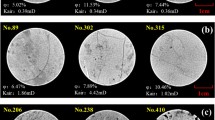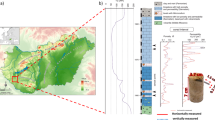Abstract
Despite numerous studies carried out on permeability estimation from either 2D/3D images or models, a precise evaluation of the permeability for carbonate rocks is still a challenging issue. In this study, the capability and advantages of pore network parameters extracted from 2D thin-section images as inputs of intelligent methods for permeability estimation of carbonate rocks are explored. Pore network extraction in image processing is an effective approach for microstructure analysis. A physically practical pore network is not just a portrayal of the pore space in the context of both morphology and topology, but also a valuable instrument for predicting transport properties precisely. In the current research, a comprehensive workflow was first presented to extract the pore network parameters from a set of core thin-section microscopic images from the carbonate reservoir rock of the South Pars gas field located in the southern borders of Iran. Subsequently, an artificial neural network (ANN) model was designed to predict the permeability of the considered samples using the extracted pore network parameters. To highlight the efficiency of the proposed approach, the second ANN model was implemented to estimate the permeability of the samples using the conventional well log data. The quantitative comparison of the obtained results using both ANN-based models reveals a significant enhancement in the predicted permeability through the extracted pore network parameters.














Similar content being viewed by others
References
Aali J, Rahmani O (2012) H2S—origin in South Pars gas field from Persian gulf Iran. J Petrol Sci Eng 86:217–224
Afshari A, Shadizadeh S, Riahi M (2014) The use of artificial neural networks in reservoir permeability estimation from well logs: focus on different network training algorithms. Energy Sour Part A: Recover, Util Environ Effects 36:1195–1202
Akin S, Ross C, Kovscek A (2008) Combination of well log and pore-scale data to predict petrophysical properties of diatomite. J Petrol Sci Eng 60:133–149
Ali M, Chawathé A (2000) Using artificial intelligence to predict permeability from petrographic data. Comput Geosci 26:915–925
Aliouane L, Ouadfeul S-A, Boudella A Back Propagation and Hidden Weight Optimization Algorithms Neural Network for Permeability Estimation from Well-Logs Data in Shaly Sandstone Petroleum Reservoirs: Application to Algerian Sahara. In: Conference of the Arabian Journal of Geosciences, 2018. Springer, pp 25-27
Anselmetti FS, Luthi S, Eberli GP (1998) Quantitative characterization of carbonate pore systems by digital image analysis. AAPG Bull 82:1815–1836
Archilha NL et al (2016) Permeability and acoustic velocity controlling factors determined from x-ray tomography images of carbonate rocks. AAPG Bull 100:1289–1309
Ari W, Nana Higiana H (2015) Quantitative characterization of carbonate pore systems on Jonggrangan formation using digital image analysis (Dia). In: Proceeding, seminar Nasional Kebumian Ke-8 academia-industry linkage 15-16 Oktober 2015; Grha Sabah Pramana. Departmen Teknik Geologi
Asadisaghandi J, Tahmasebi P (2011) Comparative evaluation of back-propagation neural network learning algorithms and empirical correlations for prediction of oil PVT properties in Iran oilfields. J Petrol Sci Eng 78:464–475
Basbug B, Karpyn ZT (2007) Estimation of permeability from porosity specific surface area and irreducible water saturation using an artificial neural network. In: Latin American and Caribbean Petroleum Engineering conference. Society of Petroleum Engineers
Berryman JG, Blair SC (1986) Use of digital image analysis to estimate fluid permeability of porous materials: Application of two-point correlation functions Journal of applied. Physics 60:1930–1938
Crowther PS, Cox RJ (2005) A method for optimal division of data sets for use in neural networks. In: International conference on knowledge-based and intelligent information and engineering systems, Melbourne, Australia. Springer, pp 1–7. https://doi.org/10.1007/115540281
de Oliveira GLP, Ceia MA, Missagia RM, Neto IL, Santos VH, Paranhos R (2020) Core plug and 2D/3D-image integrated analysis for improving permeability estimation based on the differences between micro-and macroporosity in middle east carbonate rocks. J Petrol Sci Eng 193:107335
Edgell H (1977) The Permian system as an oil and gas reservoir in Iran, Iraq and Arabia. In: Proc. Second Iranian Geological Symposium, Tehran. pp 161–201
Engelbrecht AP (2007) Computational intelligence: an introduction. Wiley
Ghiasi-Freez J, Kadkhodaie-Ilkhchi A, Ziaii M (2012) Improving the accuracy of flow units prediction through two committee machine models: an example from the South Pars gas field Persian Gulf Basin, Iran. Computers Geosci 46:10–23
Goins E, Reedy C (2000) Digital image analysis in microscopy for objects and architectural conservation. Obj Spec Group Postprints Am Institut for Conser Hist Artistic Works 7:122–137
Gonzalez RC, Woods RE, Eddins S (2004) Digital Image Processing Using MATLAB: Pearson Prentice Hall Upper Saddle River, New Jersey
Hamada G, Elshafei M (2010) Neural network prediction of porosity and permeability of heterogeneous gas sand reservoirs using NMR and conventional logs. Nafta 61:451–465
Hammerstrom D (1993) Working with neural networks. IEEE Spec 30:46–53
Helle HB, Bhatt A, Ursin B (2001) Porosity and permeability prediction from wireline logs using artificial neural networks: a North Sea case study. Geophys Prospect 49:431–444
Heydari E, Wade WJ, Hassanzadeh J (2001) Diagenetic origin of carbon and oxygen isotope compositions of Permian-Triassic boundary strata. Sed Geol 143:191–197
Huang Z, Shimeld J, Williamson M, Katsube J (1996) Permeability prediction with artificial neural network modeling in the Venture gas field, offshore eastern Canada. Geophysics 61:422–436
Irani R, Nasimi R (2011) Evolving neural network using real coded genetic algorithm for permeability estimation of the reservoir. Expert Syst Appl 38:9862–9866
Jamialahmadi M, Javadpour F (2000) Relationship of permeability, porosity and depth using an artificial neural network. J Petrol Sci Eng 26(2):35–239
Kalam S, Khan M, Mahmoud M, Khan RA, Abu-Khamsin SA (2020) New Vision into Relative Permeability Estimation Using Artificial Neural Networks. In: SPE Asia Pacific Oil & Gas Conference and Exhibition, 2020. Society of Petroleum Engineers. https://doi.org/10.2118/202810-MS
Kaydani H, Mohebbi A (2013) A comparison study of using optimization algorithms and artificial neural networks for predicting permeability. J Petrol Sci Eng 112:17–23
Lim J-S, Kim J (2004) Reservoir porosity and permeability estimation from well logs using fuzzy logic and neural networks. In: SPE Asia Pacific oil and gas conference and exhibition. Society of Petroleum Engineers. https://doi.org/10.2118/88476-MS
Mohaghegh S, Arefi R, Ameri S, Aminiand K, Nutter R (1996) Petroleum reservoir characterization with the aid of artificial neural networks. J Petrol Sci Eng 16:263–274
Nabawy BS (2014) Estimating porosity and permeability using Digital Image Analysis (DIA) technique for highly porous sandstones Arabian. J Geosci 7:889–898
Najman L, Schmitt M (1994) Watershed of a continuous function. Signal Process 38:99–112
Nazari MH, Tavakoli V, Rahimpour-Bonab H, Sharifi-Yazdi M (2019) Investigation of factors influencing geological heterogeneity in tight gas carbonates Permian reservoir of the Persian Gulf. J Petrol Sci Eng 183:106341
Okon AN, Adewole SE, Uguma EM (2020) Artificial neural network model for reservoir petrophysical properties: porosity, permeability and water saturation prediction. Model Earth Syst Environ. https://doi.org/10.1007/s40808-020-01012-4
Peng S, Hassan A, Loucks RG (2016) Permeability estimation based on thin-section image analysis and 2D flow modeling in grain-dominated carbonates. Marine Petrol Geol 77:763–775
Rahimpour-Bonab H, Asadi-Eskandar A, Sonei R (2009) Effects of the permian-triassic boundary on reservoir characteristics of the South Pars gas field Persian Gulf. Geol J 44:341–364
Rahimpour-Bonab H, Enayati-Bidgoli A, Navidtalab A, Mehrabi H (2014) Appraisal of intra-reservoir barriers in the Permo-Triassic successions of the Central Persian Gulf Offshore Iran. Geologica acta 12:0087–0107
Rahman MH, Pierson BJ (2011) Effects of microporosity on permeability and sonic velocity of Miocene carbonates and an approach to relate micrite microtextures with microporosity occurrences in Miocene carbonate reservoirs of offshore Sarawak, Malaysia. In: SEG Technical Program Expanded Abstracts 2011. Society of Exploration Geophysicists, pp 2059–2063. https://doi.org/10.1190/1.3627614
Rostami A, Baghban A, Mohammadi AH, Hemmati-Sarapardeh A, Habibzadeh S (2019) Rigorous prognostication of permeability of heterogeneous carbonate oil reservoirs: Smart modeling and correlation development. Fuel 236:110–123
Sarkar P, Kumar A, Singh KH, Ghosh R, Singh TN (2018) Pore system, microstructure and porosity characterization of Gondwana shale of Eastern India using laboratory experiment and watershed image segmentation algorithm. Marine Petrol Geol 94:246–260
Shahin MA, Maier HR, Jaksa MB (2004) Data division for developing neural networks applied to geotechnical engineering. J Comput Civ Eng 18:105–114
Sharland P et al (2001) Arabian plate sequence stratigraphy. Gulf PetroLink, Bahrain
Shokir EE-M, Alsughayer A, Al-Ateeq A (2006) Permeability estimation from well log responses. J Can Petrol Technol 45:41-46. https://doi.org/10.2118/06-11-05
Song Z, Zhou QY (2019) Micro-scale granite permeability estimation based on digital image analysis. J Petrol Sci Eng 180:176–185
Sun H, Vega S, Tao G (2017) Analysis of heterogeneity and permeability anisotropy in carbonate rock samples using digital rock physics. J Petrol Sci Eng 156:419–429
Szabo F, Kheradpir A (1978) Permian and Triassic stratigraphy, Zagros basin, south-west Iran. J Pet Geol 1:57–82
Tavakoli V (2021) Permeability’s response to dolomitization, clues from Permian-Triassic reservoirs of the central Persian Gulf. Marine Petrol Geol 123:104723
Tavakoli V, Jamalian A (2018) Microporosity evolution in Iranian reservoirs, Dalan and Dariyan formations, the central Persian Gulf. J Nat Gas Sci Eng 52:155–165
Tavakoli V, Jamalian A (2019) Porosity evolution in dolomitized Permian-Triassic strata of the Persian Gulf, insights into the porosity origin of dolomite reservoirs. J Petrol Sci Eng 181:106191
Tavakoli V, Rahimpour-Bonab H (2012) Uranium depletion across Permian-Triassic Boundary in Persian Gulf and its implications for paleooceanic conditions Palaeogeography. Palaeoclimatol, Palaeoecol 350:101–113
Trauth MH (2015) Image processing. In: MATLAB® recipes for earth sciences. Springer, New York, pp 315–374
Trauth MH, Gebbers R, Marwan N, Sillmann E (2007) MATLAB recipes for earth sciences, vol 34. Springer
Weger RJ, Eberli GP, Baechle GT, Massaferro JL, Sun Y-F (2009) Quantification of pore structure and its effect on sonic velocity and permeability in carbonates. AAPG Bull 93:1297–1317
Yu Y, Visser F, Amro MM (2014) Quantitative Effect of Microporosity on Permeability in Carbonate Reservoirs. In: International Petroleum Technology Conference Kuala Lumpur, Malaysia
Zhou K, Hou J, Fu H, Wei B, Liu Y (2017) Estimation of relative permeability curves using an improved Levenberg-Marquardt method with simultaneous perturbation Jacobian approximation. J Hydrol 544:604–612
Zimmerman RW, Jing X, Lock PA, Jurgawczynski M (2007) Permeability predictions based on two-dimensional pore space images. In: SPE Annual Technical Conference and Exhibition. Society of Petroleum Engineers. https://doi.org/10.2118/110472-MS
Author information
Authors and Affiliations
Corresponding author
Additional information
Communicated by Jadwiga Anna Jarzyna, prof (ASSOCIATE EDITOR).
Rights and permissions
About this article
Cite this article
Jamshidi Gohari, M., Emami Niri, M. & Ghiasi-Freez, J. Improving permeability estimation of carbonate rocks using extracted pore network parameters: a gas field case study. Acta Geophys. 69, 509–527 (2021). https://doi.org/10.1007/s11600-021-00563-z
Received:
Accepted:
Published:
Issue Date:
DOI: https://doi.org/10.1007/s11600-021-00563-z




